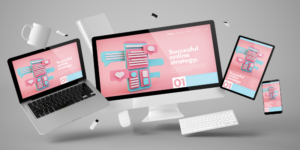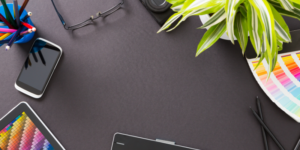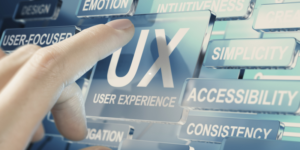In recent years, we have witnessed a fascinating resurgence of retro design trends being adopted and reinterpreted in the digital era. As we move towards an increasingly technological world, it seems paradoxical that we are drawn to the charm and nostalgic aesthetics of the past. However, this blend of analog and digital is redefining the landscape of contemporary design, bringing a fresh creative approach and visually captivating experiences.
The influence of the past on current design
The first part of this article explores how retro design has been a source of inspiration for modern designers. By looking at styles from past decades such as the 1920s art deco or the 1960s psychedelic movement, we can see how these styles continue to influence contemporary design. We will examine how elements like vibrant colors, vintage typography, and geometric patterns are being reintegrated into digital design, evoking a sense of nostalgia and personality.
The revival of analog photography
The second section of the article delves into the growing trend of analog photography in the digital era. While digital technology has revolutionized how we capture and share images, many photographers and enthusiasts are rediscovering the charm and unique quality of analog cameras. We will explore how retro design is incorporated in photography, from the choice of analog films to vintage aesthetics applied in post-production editing.
Digital interfaces with a touch of nostalgia
In the third part of this article, we will dive into the world of digital interfaces with a retro approach. We will see how designers are utilizing vintage design elements to create user interfaces that harken back to old times while providing a modern and intuitive experience. We will examine the use of physical buttons, textures, and color palettes inspired by past decades to create an engaging and familiar experience for users.
The role of retro design in brand identity
The fourth section of this article highlights how retro design is being embraced as an effective strategy in building brand identity. We will explore how companies are using retro design elements in their logos, packaging, and marketing materials to evoke a sense of trust, authenticity, and emotional connection with the audience. We will analyze examples of brands successfully incorporating retro design in their brand strategy.
Conclusion
As we move towards an increasingly digital future, the retro design trend has played a significant role in creating visually and emotionally engaging experiences. From analog to digital, we have seen how retro elements are being reinterpreted and integrated into contemporary design, adding a new layer of creativity and connection. It reminds us that despite technological advancements, our roots and memories are an essential part of who we are, and retro design allows us to revisit those experiences in a refreshed way.
As we continue to explore and embrace these retro design trends in the digital era, it is exciting to think about the future possibilities. Blending the charm of the past with advanced technologies today will open doors to new forms of creative expression and memorable user experiences. Retro design reminds us that timeless aesthetics and nostalgia hold a profound power of emotional connection, and its influence will continue to shape the design landscape in the years to come.
The resurgence of retro design in the digital era has brought about a renewed appreciation for the aesthetics and craftsmanship of the past. This shift in design trends reflects our longing for a sense of authenticity and uniqueness in an increasingly digital and homogenized world.
One notable aspect of the retro design movement is the focus on craftsmanship and attention to detail. In a time where mass production and automation dominate, retro design celebrates the artistry and human touch that was prevalent in earlier eras. From hand-drawn illustrations to intricate typography, retro design brings back the art of creating visually appealing and thoughtfully crafted designs.
Another aspect of retro design that has captured the imagination of designers is its ability to evoke nostalgia and create emotional connections. By drawing inspiration from design styles of the past, designers can tap into collective memories and create designs that resonate with their audience on a deeper level. Whether it’s the use of vintage color palettes, familiar iconography, or retro-inspired imagery, these design elements trigger a sense of nostalgia and familiarity, making the user feel a connection to the design and the brand behind it.
Furthermore, retro design allows for experimentation and creative exploration. By revisiting and reinterpreting design styles from the past, designers can push the boundaries of what is considered modern and contemporary. The blending of retro aesthetics with modern technology and techniques creates a unique juxtaposition that sparks curiosity and captivates the audience. This fusion of old and new opens up a world of possibilities for designers to create innovative and visually stunning designs.
In addition to its visual appeal, retro design also offers practical benefits in terms of usability and accessibility. The simplicity and clarity of retro design elements make them highly legible and easy to navigate. By focusing on clean lines, bold typography, and intuitive layouts, retro-inspired designs can enhance user experiences and ensure that information is communicated effectively.
As designers continue to explore the possibilities of retro design in the digital era, it is important to strike a balance between homage to the past and innovation for the future. Retro design should not be limited to mere imitation or replication of past styles, but rather a reinterpretation and integration of retro elements into contemporary design practices.
In conclusion, the resurgence of retro design in the digital era has brought about a fresh perspective and a renewed appreciation for the aesthetics and principles of the past. By embracing retro design elements, designers can create visually captivating designs that evoke nostalgia, establish emotional connections, and push the boundaries of modern design. As we navigate the ever-evolving landscape of design, the influence of retro design will continue to shape and inspire future design trends, bridging the gap between the past and the future.



